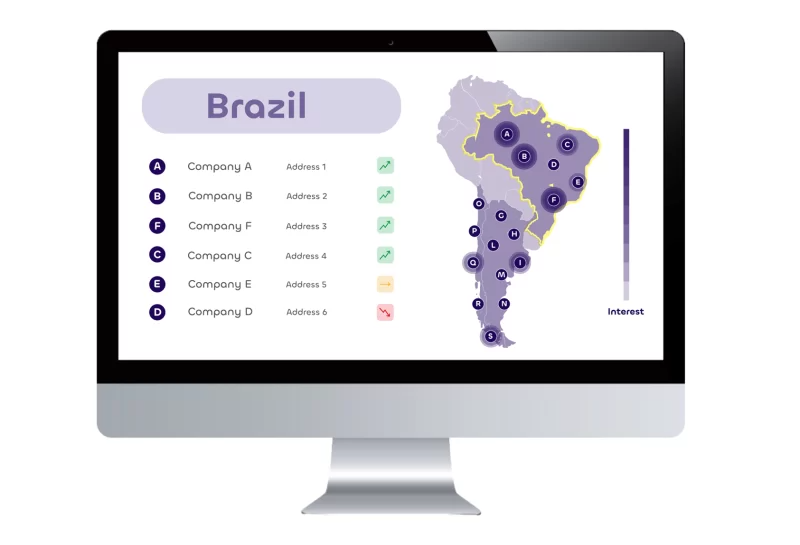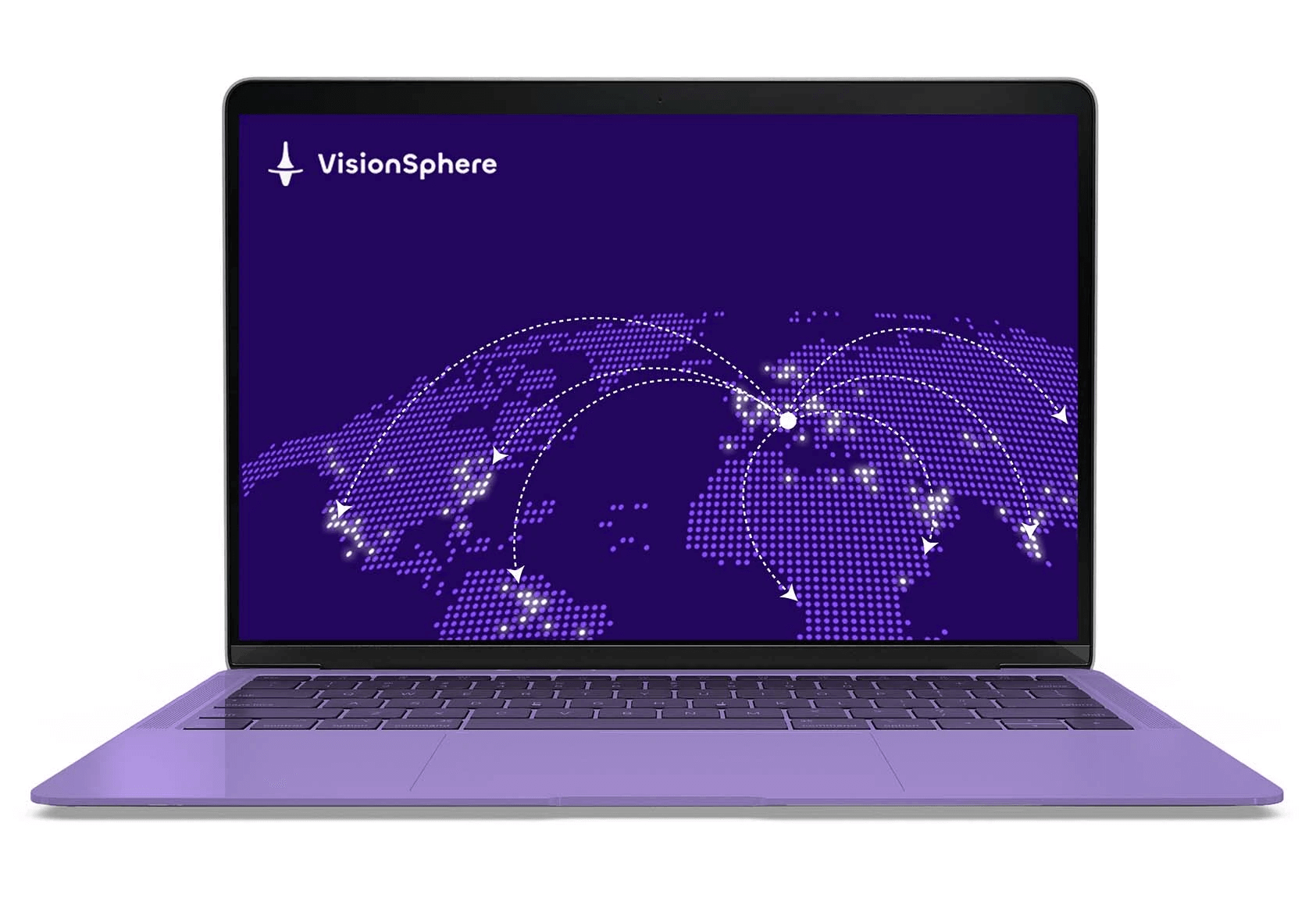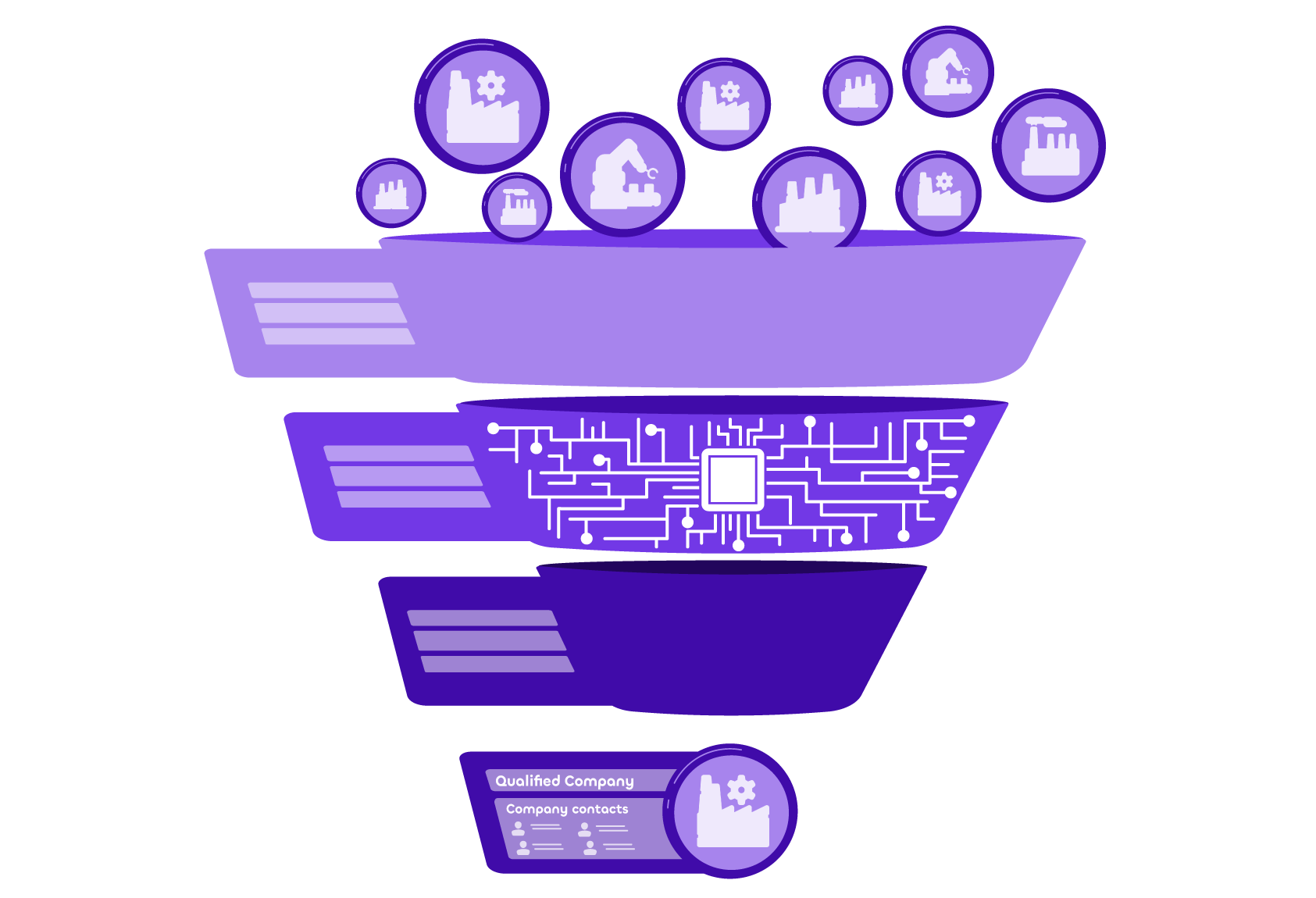Go-to-market (GTM) strategy in B2B is crucial to the success of a product in a new market. Tools such as Business Intelligence (BI), therefore, play an essential role, allowing you to obtain valuable insights to optimize go-to-market strategies.
To ensure optimal results it is essential to have the correct information to avoid wasting resources such as time and money.
Before proceeding with the post, we must define what is meant by Business Intelligence and go-to-market strategies in the B2B market. Business Intelligence is a set of processes, tools, and technologies used to collect, analyze, and present business data in order to support informed decision-making. Go-to-market, on the other hand, is a strategy that defines how a company brings a new product or service to the market, identifying distribution channels, target markets, and marketing tactics.
The term go-to-market is also used to define the set of analyses and actions that a company carries out to approach the market of a new country, be it a new country, a new region, or a new B2B sector. In a similar context, VisionSphere is an ideal analytical and strategic tool that effectively supports you in all go-to-market phases: prior, in progress, or consolidation.
B2B Go-To-Market strategies until today
Go-to-market strategy, companies rely on traditional tools that include retrospective market analysis, industry research, and demographic data. This data is often considered part of “big data,” which represents a vast set of information that is used to analyze and understand the target market and its dynamics. Historical data, while valuable, may not accurately reflect the current market situation, as conditions can change quickly and unexpectedly. For example, consumer trends, business preferences, and competitive dynamics may evolve in response to external factors such as economic, technological, or social changes.
B2B Go-To-Market strategies with Business Intelligence tools such as VisionSphere
These limitations make it crucial to use advanced Business Intelligence tools, such as VisionSphere, which allows companies to gain insights into B2B companies in the present with one foot in the future. VisionSphere offers an innovative approach to Business Intelligence for B2B go-to-market. It is, in fact, a kind of software that allows you to analyze in real-time the behavior of potential customer companies within a given market, providing immediate and updated insights on trends and needs. It is a tool that allows companies to make more informed and reactive decisions based on current analyses, optimizing their market entry strategies.
Case study: Go-to-market in South America
Let’s now see how Business Intelligence can effectively integrate into decision-making processes by providing valuable insights into B2B companies. But before proceeding, let’s define what is meant by insights on B2B companies with VisionSphere: we consider insights as single or combined data that help us obtain precise and useful information to make strategic choices regarding the period (when?), the research topic (what ?) that the monitored companies (who?) express.
In the context of international expansion, many companies are faced with the challenge of conquering new markets, including South America. In this scenario, a company decided to use VisionSphere as an integral part of its go-to-market strategy for South America.
Scenario
A US-based technology company we’ll call Cloud-ERP, specializing in the development of business management software, has identified South America as a potentially profitable market for its new product: a cloud-based business management system. In the first preliminary analysis, the company reduced and concentrated its focus on three countries: Argentina, Chile, and Brazil.
The company’s objective is well defined: to identify the country to approach for entry into the South American market.
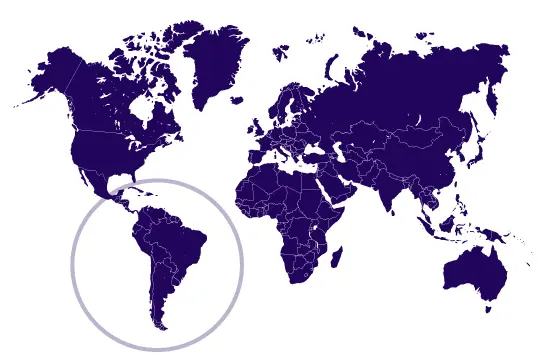
1. Creating campaigns with VisionSphere
Cloud-ERP relies on VisionSphere to gather insights that can help the company choose the country with the greatest potential. Through VisionSphere, the company must create three different campaigns, 1 for each country:
- Chile campaign
- Brazil campaign
- Argentina campaign
By doing so, the data collected by VisionSphere will be divided by country for a better evaluation of the data.
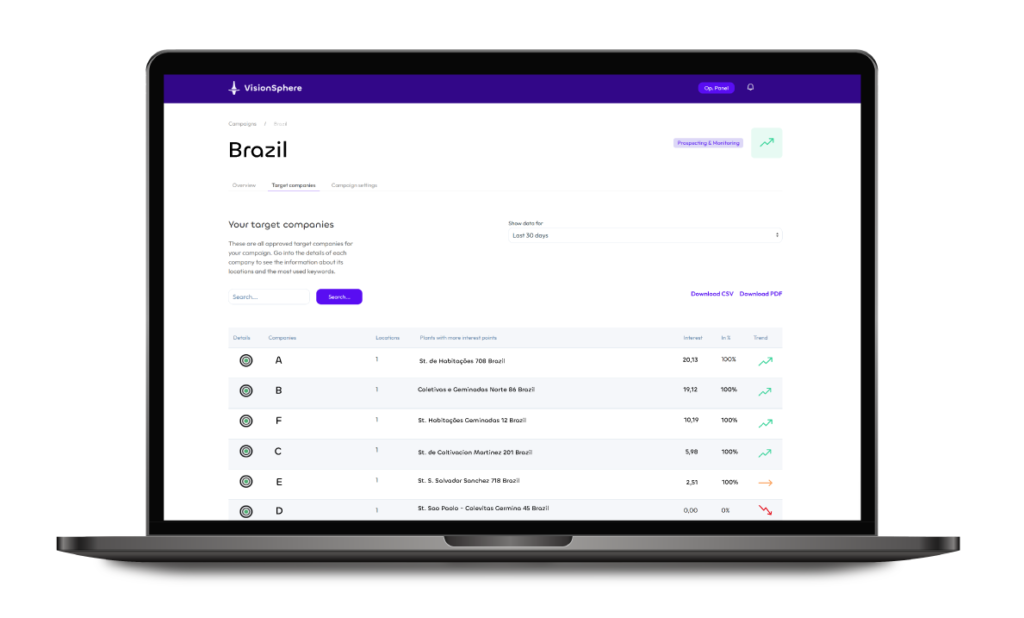
Keywords
The first step in creating campaigns with VisionSphere is to identify the most relevant terms for the company’s business, terms that target companies use to search online for cloud management software services in this case. Here is an example of keywords that Cloud-ERP has included in its campaigns:
- “Cloud-ERP” (because it wants to be aware that target companies are looking for its brand name online)
- “ERP cloud” (although in English, we cannot completely exclude that online searches for large companies can also be in an international language to search for the best products on the market)
- “Sistema de gestión de la nube” (“cloud management system” in the local language)
These Keywords are fundamental for Cloud-ERP: they clearly identify the type of product it markets.
Target companies
Once you have defined what you want to monitor Cloud-ERP with VisionSphere, you must define who to monitor. Instead of searching online which companies can be targets for your business, Cloud-ERP has inserted a list of its client companies into VisionSphere to take advantage of the Similarity function: a function that analyzes the client companies inserted to find turnover patterns and product sectors, arriving to return a list of relevant companies to be put under observation.
Repeating this procedure for each country Cloud-ERP has nowa clear and defined overview of which companies similar to your customers are present in the 3 countries.
Already in this first phase of setting up the Cloud-ERP campaign he can start making the first evaluations since he clearly knows: who his target companies are in the respective countries and the size of the individual companies in terms of turnover.
Now the campaigns are ready, VisionSphere will monitor the companies and report to Cloud-ERP which company will carry out the search, what they will have searched for, and when.
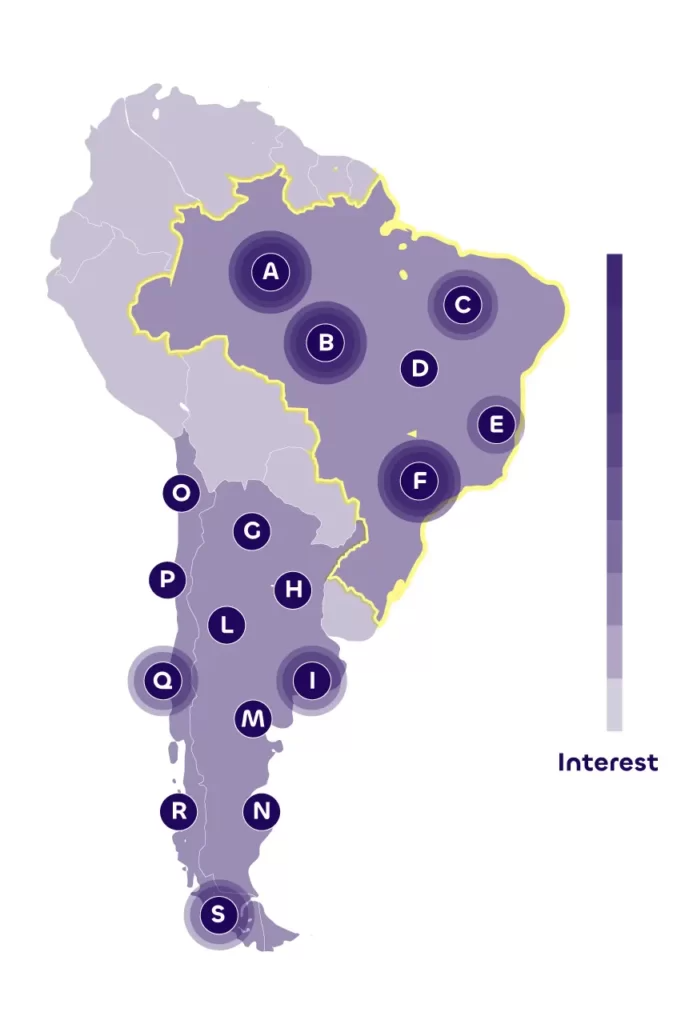
2. Preventive analysis thanks to VisionSphere Business Intelligence
Using VisionSphere Cloud-ERP allows you to monitor the basic state of your commercial sector without commercial inputs. This type of monitoring is able to give Cloud-ERP a clear idea of the behavior of the monitored companies without commercial input ( online ads, trade fairs, email marketing)
VisionSphere data, therefore, allows Cloud-ERP to clearly understand: “when?”, “Who?” and “What? ” the target companies are interesting, providing the company with a clear reflection of the corporate fabric of the countries monitored for its product sector by intercepting insights on the B2B companies monitored in real-time. Thanks to this detailed and updated information, Cloud-ERP now has the necessary tools to make informed strategic decisions on the areas in which to launch a go-to-market strategy, thus choosing the country where to make the first approach between Argentina, Chile, and Brazil. Cloud-ERP assessed the opportunities and potential returns in each country through the interests intercepted by VisionSphere, identifying the companies with the greatest interest and greatest potential in Brazil.
In this way, VisionSphere provided the company with the clarity and confidence needed to select the most suitable country to launch targeted and effective go-to-market strategies.
3. Start go-to-market strategy
Once its target companies in the defined country have been identified and detailed insights on the monitored B2B companies have been obtained, the company uses the data provided by VisionSphere to develop targeted marketing and promotion strategies on specific topics and real needs expressed by its target companies. In this way, it is possible to optimize and better channel resources.
For example, Cloud-ERP noted from VisionSphere that monitored companies in Brazil are looking for a management solution that integrates with their machinery’s IT systems. This is a precious insight that allows Cloud-ERP to launch precise Ads and email marketing campaigns on companies: A, B and F; advertising its software by emphasizing the ease of integration with the most popular IT systems of industrial machinery.
Additionally, while implementing this strategy, the company can continue to use VisionSphere to identify which companies respond to business stimuli at what times. Thanks to its ability to monitor the behavior of potential customers in real-time, VisionSphere allows the company to track the interactions of target companies with its marketing and promotion campaigns.
This approach allows Cloud-ERP to evaluate the effectiveness of its marketing initiatives and identify B2B companies that show greater interest and engagement. Using the data provided by VisionSphere, the company can then focus its resources on the most promising opportunities and adapt its strategy based on market responses.
4. Consolidation
In this phase, VisionSphere also continues to play a fundamental role in the consolidation of activity in the market. The company uses VisionSphere to constantly monitor market dynamics and identify additional insights to expand its customer portfolio.
Using VisionSphere, the company can analyze the evolving behaviors and needs of already acquired target companies in real-time, allowing it to adapt its offering and commercial strategy to best meet their needs. Additionally, VisionSphere provides detailed data on industry trends and competitor movements, allowing the company to maintain a competitive advantage and identify potential expansion opportunities.
Thanks to its ability to provide up-to-date and timely insights into B2B companies, VisionSphere allows Cloud-ERP to maintain a leadership position in the market and continue to grow sustainably in the long term. In summary, during the consolidation phase, VisionSphere is a valuable ally for identifying and making the most of growth opportunities in the B2B market.
In conclusion, the case study clearly illustrates how the use of VisionSphere has allowed Cloud-ERP to successfully address the challenges related to the expansion of its business in South America’s B2B market. From the preventive analysis phase to implementation and consolidation, VisionSphere provided Cloud-ERP with the necessary and fundamental insights to make informed decisions at every stage of the go-to-market process. Thanks to its ability to provide detailed and up-to-date insights into market dynamics and the behaviors of target companies, VisionSphere has allowed the company to optimize its commercial and marketing strategies, concentrating resources on the most promising opportunities and quickly adapting its strategy based on market responses.
Conclusion
In conclusion, the use of Business Intelligence , particularly through VisionSphere , plays a fundamental role in the definition and implementation of go-to-market strategies in the B2B context. By providing real-time insights into market dynamics and customer behaviors, VisionSphere enables companies to quickly adapt to changing market conditions, gaining a significant competitive advantage.

